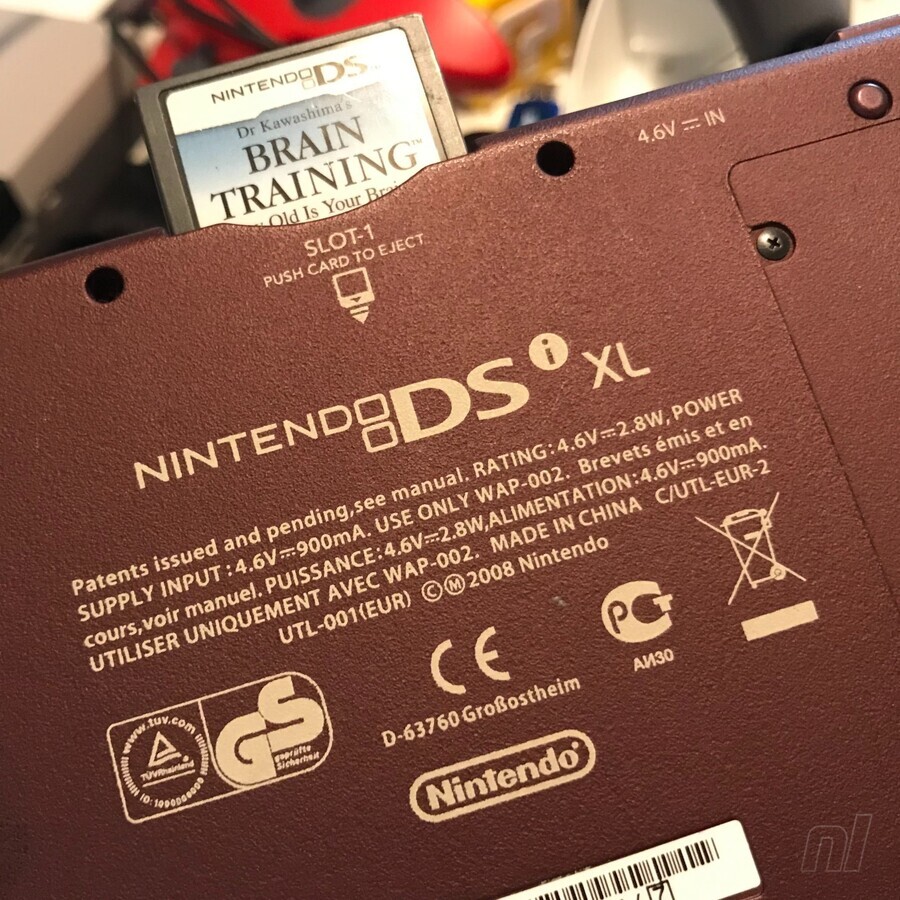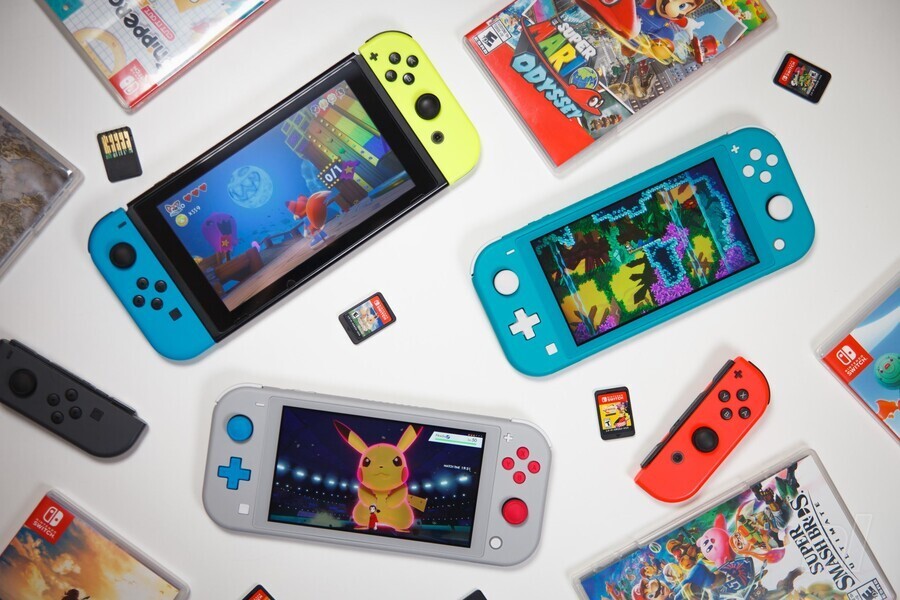GameCube (DOL)
The GameCube's product code comes from the console's development codename, Dolphin.
Just like all the others, the DOL product code extends to all GameCube peripheral hardware and software, from the Wavebird (DOL-004) to the Wavebird Wireless Receiver (DOL-005) and beyond. And if you're wondering, the DK Bongos were DOL-021.
Nintendo DS (NTR) / DS Lite (USG) / DSi (TWL) / DSi XL (UTL)
The Nintendo DS carried the codename Nitro throughout development and its NTR product code reflects that, rather than the 'Dual Screen' of the console's name.

The DS Lite, though, switched to the seemingly unrelated USG code (although there is speculation that it referred to the Japanese word usugata, meaning 'thin' or 'slim').
Things then got decidedly more complex with the Nintendo DSi (TWL-001) and DSi XL (UTL-001) and the jury's out on exactly what those abbreviations are short for. We could have a go, but when it comes to guessing abbreviations, our minds invariably produce schoolboy-level rudeness. Hilarious, but hardly enlightening.

Wii (RVL)
The Wii's product code is RVL and refers to the console's codename, Revolution. Not much else to say on this one. Nice and simple, which is more than you can say for the next 'family' of consoles...
Nintendo 3DS Family (WTF...)
Okay, if you thought the original DS product codes got complicated, you ain't seen nothing yet.
The first 3DS (ours was Aqua) had the code CTR-001. There's been no official confirmation of that code's origins, although speculation ranges from 'Control' to 'Citrus'.

The 3DS XL (ours was Red and Black) was the SPR-001.
The New Nintendo 3DS (you did want a running commentary of our personal console colour choices, right? - ours was White) was KTR-001.
The New Nintendo 3DS XL (we didn't have one of those) was RED-001.
The Nintendo 2DS (the original non-folding 'doorstop' one for the kids) was the FTR-001.
And finally, the New Nintendo 2DS XL (the one where you had to check a chart and look on the shelf to make sure you didn't already own it) carried the code JAN-001. We can confirm that by the sixth hardware iteration Nintendo's engineers were just naming them after their aunties or using a random generator to churn out the product codes. Probably.

Wii U (WUP)
The Wii U was known as Project Cafe during development, although the product code on the console is WUP-001. 'Wii U Project', perhaps? It's never been made clear, but rumours that it stood for 'WUPsie-daisies' are almost certainly false.
Classic Mini consoles (CLV) and amiibo (NVL)...

Nintendo's mini plug-and-play consoles, the NES Classic Mini, Famicom Classic Mini and US SNES Classic Mini carry the codes CLV-001, CLV-101 and CLV-201 respectively (with the Japanese Super Famicom and EU SNES editions labelled CLV-301, as seen in the above photo).
All the amiibo figures on your shelf are stamped with the code NVL-001, with amiibo cards labelled NVL-101 and the yarn amiibo NVL-201.
Nintendo Switch (HAC) / Switch Lite (HDH) / Switch OLED (HEG)

And we arrive, finally, at Nintendo's latest console, the Switch. In the run-up to its reveal we knew nothing but the console's codename: the short-and-sweet, futuristic-sounding 'NX'. However, as we stated in the intro, the OG console launched with the product code HAC-001. Hybrid Ability Console? Home And Carry-able? Haven't Any Clue?...
We're none the wiser to any deeper meaning at the moment, and the Switch Lite has a totally different product code, too: HDH-001. And Switch OLED is HEG-001.
And there you have it. Have we missed any? Got some bright ideas as to the meaning behind some of the product codes with unknown origins? Feel free to share your ideas below.





Comments 30
This feature is super dumb and I love it
I love you Nintendo
The iQue Player (BB, or sometimes BL1) is the funniest in my opinion.
CLV probably stands for Clover. KTR and FTR are just variations on CTR, implying it's the base model. RED might be 'redesign'?
I remember in Smash Bros, the Palutena's guidance for R.O.B. refers to him as HVC-012, and now it all makes entirely too much sense as to why.
HDH, High Definition Handheld?
I love features like this. (Seriously!)
You know you’re a geek you find this article thoroughly interesting and engrossing from start to finish! Thanks for this 😀
Handheld And Console
HanDHeld or High Definition Handheld
Also, fun fact, since the Switch Pro Controller uses the same battery as the original 3DS, the battery's code is CTR-003
I still think Wii U means Wii upgraded. It’s just that it should have been released 3 years prior to when it was, then the message would have been clear. Hd Wii with a bulky Gamepad that is actually awesome. Our Wii U is still in use at our house. Mostly for tv and the hundreds of retro game’s. But it’s because the Gamepad is so easy to use.
This is a neat feature.
It's made me try to think of how and where this information is actually useful (and would have been a good question to pose at the end of this article).
The only one I can think of and is probably the most known, are the GBA codes. Knowing to look for an AGS-101 instead of an AGS-001 for the backlit screen.
Wow, just genius Nintendo.
@Cotillion I see your are a man of culture as well, AGS-101 FTW! Great for og GBA modding.
I remember noticing those codes, and figuring out most myself. I came here hoping to get some of the seemingly non-sensical sorted out, but found a fun article informing me that it's apparently anyone's guess. I was kind of hoping -not that it matters- for the Switch to be a reference to "NX" with some third letter. But HAC just seems like a challenge... And stability updates when you're too close to winning it.
HAC = Handheld Console; HDH = Handheld, perhaps.
Pretty sure the CTR of the original 3DS is Citra, is it not? I thought the official 3DS emulator was called that, like the official DS emulator was Nitro.
Nintendo Revolution should have been the name of the Wii U - you could have Wii and Revolution side by side.
for some reason these code names makes me want Nintendo to release an Nintendo 64 classic mini. we already have NES and SNES classic mini systems. its time for the N64 to join the club. or at least add some of those games to the Nintendo Switch online game catalog.
the feature I never knew I needed
The dev units had numbers too.
The GameCube dev box, aka the NPDP-GDEV, was GCT-0100.
GameCube NR Reader (the green GameCube that read Non-Retail discs) was DOT-001.
Don’t know the model number of the red GameCube NPDP reader but I’m sure it had one.
The Wii dev box was RVT-001.
The green Wii NR Reader, aka the RVT-R, was RVT-002. The NR discs themselves were RVT-004.
The red Wii dev unit with a built-in hard drive, aka the RVT-H, was RVT-005.
The Wii U dev box, aka the CAT-DEV (Cafe Tool for Development) was WUT-001 (I kid you not).
The green Wii U final debug unit, aka the CAT-R, was WUT-002.
Notice that all the dev units had “T” replacing the last letter of what would have been the retail unit’s model category
Oh.., and the two dev versions of the Wii U Gamepad were WUT-003 and WUT-004. The WiiU NR Discs (used by the CAT-DEV and CAT-R) were WUT-007
This is what you get when Nintendo have no news to share, and to be honest I would be pretty surprised if Nintendo did not have a lot of first party games in production right now, so why the silence for so long?, I know the latest situation with the virus can't be helping matters, but that did not really start to impact until around December 2019, so Nintendo should have been well on with development of thee games by then.
OXY from Game Boy Micro stands for Oxygen, as it was developed alongside Nintendo DS (NTR > Nitro). Get it? N2O? Nitro 2 (screens) Oxygen.
The Game Boy Micro's codename in development was Oxygen, hence the OXY code.
I was extremely disappointed after reading the 3DS subtitle that the original 3DS product name wasn't WTF-001.
Switch backplate: "HAC-001"
Hackers: "See? We only ever did what this thing explicitly told us to!"
Seriously, though, it's a mystery. An interesting read overall! I've only heard of NDS's "NTR" origin before; there are even claims that at least one early game, Yu-Gi-Oh *Ni*ghtmare *Tro*badour, tried to play on the codename in the same way as the final thing would get nods like "Resident Evil: Deadly Silence" or "Advance Wars: Dual Strike". Come to think of it, Switch is probably the first Ninty console since GameCube whose name doesn't recurrently surface in game titl-........ never mind.
OH EM GEE! Even Nintendo Life is down to just releasing remasters in 2020!!
Guessing with the switch it's Nintendo Handheld And Console (HAC); where as the switch lite I guess would be Handheld Dedicated Hardware (HDH) ?
DSi (TWL) is probably Two ??? Lenses, since the camera was one of its significant additions. UTL is maybe Ura Two Lenses, since it is an upgraded version.
How sure you sure about the earlier ones (you're clearly guessing on the later ones)? It was always my understanding that AGB stood for "Atlantis Game Boy" because it was internally called "Project Atlantis".
Tap here to load 30 comments
Leave A Comment
Hold on there, you need to login to post a comment...